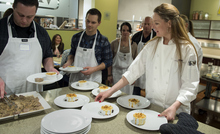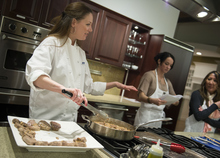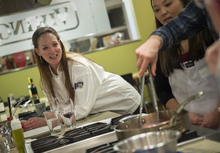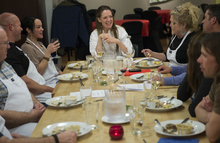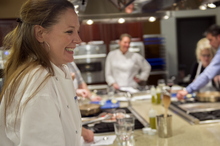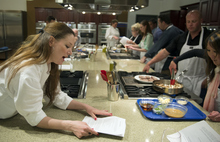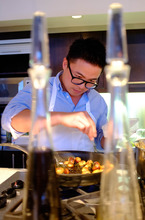This is an archived article that was published on sltrib.com in 2014, and information in the article may be outdated. It is provided only for personal research purposes and may not be reprinted.
For years, pain shot through his knees and his chef uniform was taut. But it took news from the doctor for Zane Holmquist, the executive chef at Park City's Stein Eriksen Lodge, to rework his diet a few years ago.
He biked and swam regularly, but he was teetering toward diabetes and his blood pressure had climbed. The extra weight, the doctor said, would only worsen aches from ski-related surgeries and years in the kitchen.
"I didn't go on any tricky fad diet" to trim down, said the 44-year-old Holmquist. "It was — reduce what I ate. Less chips and junk food, and smaller portions." A few days a month, he observes the Paleo diet, which shuns refined sugars, grains, beans and peanuts and focuses on food our prehistoric ancestors supposedly ate.
While their love of food is what made them become chefs, being surrounded by rich, high-calorie foods on a daily basis is one of the hazards of the culinary world. Add to that the irregular hours and high stress of being in a kitchen, and it can be a recipe for obesity.
But Holmquist and other Utah chefs are trying new ways to stay trimmer, healthier and, of course, still enjoy their food. Their methods include recent trends, such as avoiding most gluten, shopping locally and following a flexitarian diet—consuming fewer animal products and more plants.
—
Farewell to pizza • After the checkup, Holmquist, who is known for leading mountain-biking excursions and cooking for guests at trail's end, joined his wife in training for a triathlon. He searched online for how athletes eat and started reaching for pickles instead of potato chips. His routine runs to Este Pizza in Sugar House waned to rare treats.
"At breakfast I might have three eggs but no toast," he said. "I used to love pancakes and waffles. I can't remember the last time I had a pancake."
The chef whittled 30 pounds from his 5-foot, 8-inch frame, aiming to eat equal parts protein, carbohydrates and healthy fats from avocados and nuts. The knee pain that barred him from running a few years ago is now gone, for the most part. And he competes in triathlons regularly.
Others are straying from gluten, too. For Mollie Snider, who leads cooking classes at the Salt Lake Culinary Center, turning 40 launched a departure from most pasta and pizza.
"That really is a jumping-off point," she said. "At 17, you can probably go ahead and digest plastic. But those days are over."
She's wiping the wheat protein from her diet for the first three months of the new year. Avoiding it in the past revved her energy and spared her any post-meal bloat, she said.
For dinners at home, she now makes pho, the traditional Vietnamese soup. The soupy rice noodles absorb the complex flavor of the broth, so they're a tasty alternative to traditional semolina dishes, she says.
But the new experiment means a departure from a comforting family ritual. On Sunday nights, Snider and her husband used to make pizza with toppings including caramelized onions and fontina.
"Food surrounds tradition. It's our tradition," she said, referring to pizza night. "So that's going to be as hard to give up as the pizza itself."
Another of Snider's traditions will stick around. She'll continue to shop for local produce and goods such as eggs from Clifford Family Farm.
—
A fresh fix • As a recurring contestant on the Food Network, Viet Pham, co-owner of Forage in Salt Lake City, jets to Los Angeles up to a few times a week and conducts daily meetings over cocktails.
"When you do eat" during those periods, "you eat because you're stressed out, and that's not the best time to eat, you know? It ravages your body physically and mentally," he said.
On months off, Pham observes 40-day vegan or vegetarian stretches, juicing a garden's worth of produce each day. One morning, Pham pulverized a typical mix: broccoli, spinach, ginger, apples, lemons and cucumbers. He also threw in garlic cloves, beets and pineapple. Pham concedes the elixir is more swamp than smoothie.
"It's really intense," he said. "I end up with this concoction that's fairly thick and it takes a lot to drink." But it's worth it to feel lighter and more alert, he said. "It gives me a way to reset my body."
He also mines Whole Foods for vegan and gluten-free soups, then simmers them with chopped kale or other leafy vegetables. He snacks on handfuls of nuts and fruit.
Curtis Cameron, pastry chef at Stein Eriksen, opts for dark, leafy vegetables, too. He started paying more attention to his diet after medical issues dealt him a gluten intolerance a few years ago.
Cameron usually tastes a small pastry or Danish during the workday, but tries not to eat much more if he's gearing up for a trail run. The intolerance has diminished, he expects, but avoiding the wheat protein helps him feel lighter and run faster.
"I've been so happy and so healthy that I don't see me falling back into eating a lot of gluten, even if I could," he said. It's not all vegetables, though. Cameron specializes in making chocolates and bonbons, so he indulges in those, or an occasional bag of Sour Patch Kids.
—
Special accommodations • Cameron and the other cooks say they're willing to work with guests when it comes to satisfying special diets, especially if visitors call ahead.
But conforming to zero-tolerance plans or needs can prove tough going: In traditional bakeries, flour inevitably lifts and lands on gluten-free mixes, and pans used for omnivores can impart traces of meat and dairy on vegan meals.
The trickiest part? The definition of a tasty, wholesome meal diverges from one diner to the next, said Holmquist. "When people say, 'I want something healthy,' that's like the biggest trap for a chef."














